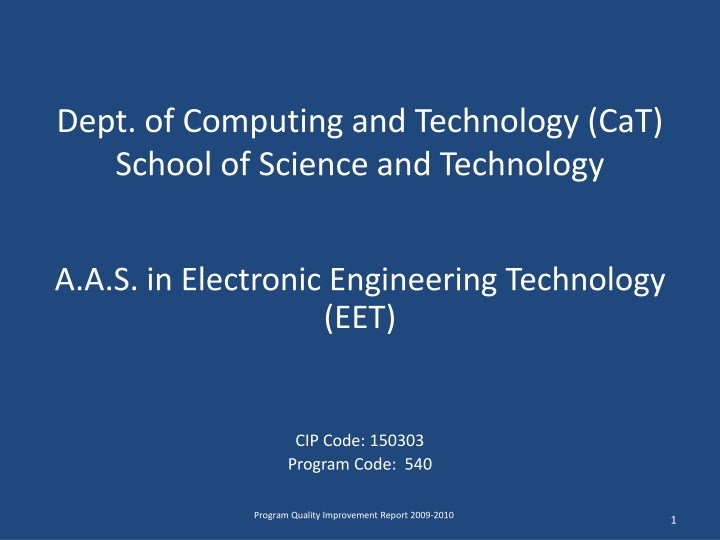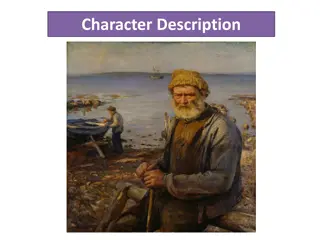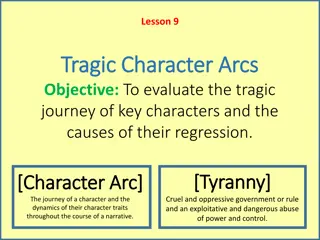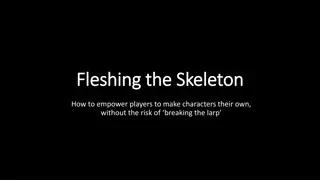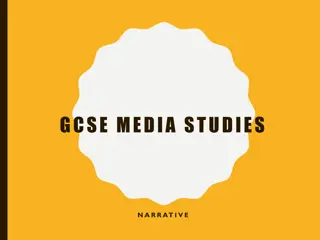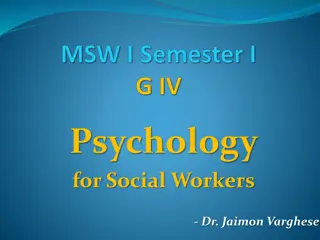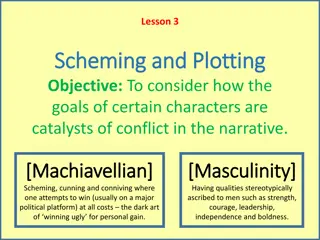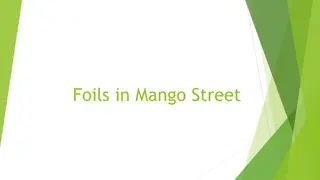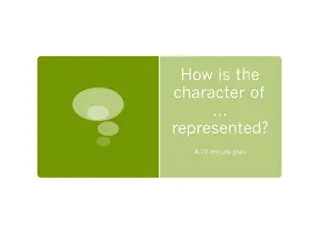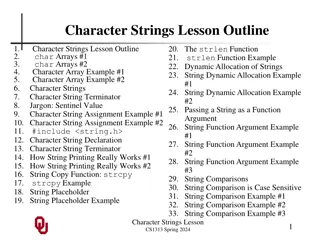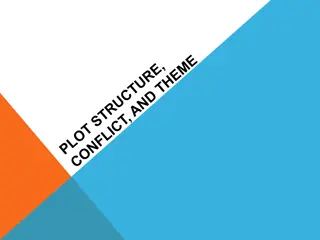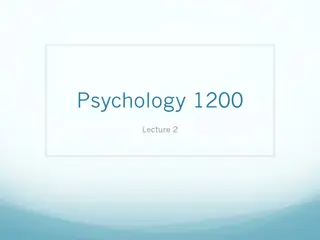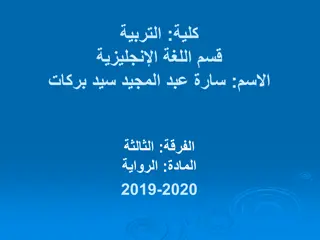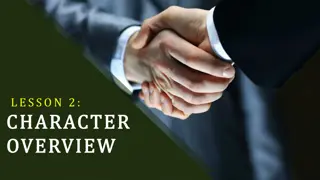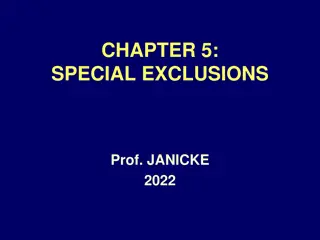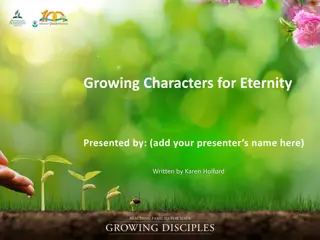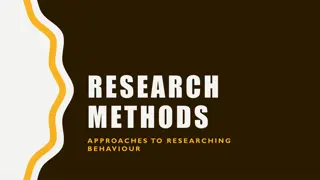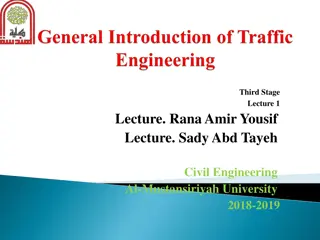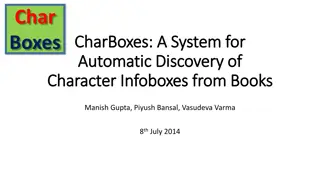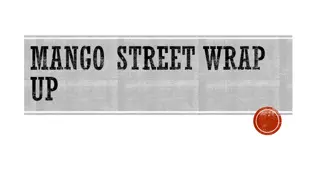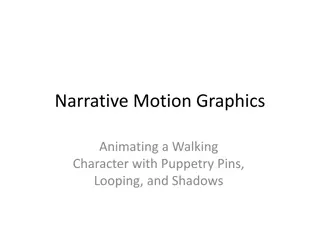Analyzing Character Behavior in Case Studies
Analyze and interpret the behaviors of main characters in three different case studies to identify their problems or positive traits. Understand how these characters can overcome their challenges or foster positive behaviors.
Download Presentation

Please find below an Image/Link to download the presentation.
The content on the website is provided AS IS for your information and personal use only. It may not be sold, licensed, or shared on other websites without obtaining consent from the author.If you encounter any issues during the download, it is possible that the publisher has removed the file from their server.
You are allowed to download the files provided on this website for personal or commercial use, subject to the condition that they are used lawfully. All files are the property of their respective owners.
The content on the website is provided AS IS for your information and personal use only. It may not be sold, licensed, or shared on other websites without obtaining consent from the author.
E N D
Presentation Transcript
Dept. of Computing and Technology (CaT) School of Science and Technology A.A.S. in Electronic Engineering Technology (EET) CIP Code: 150303 Program Code: 540 Program Quality Improvement Report 2009-2010 1
Program actions since last assessment 1. Collect data for assessment in labs. Several lab exercises were created to assess student learning using lab equipment such as the oscilloscope, multimeter, and troubleshooting skills. Hold mock interviews to assess student interview and presentation skills. Mock interviews were held last Spring semester with the Industrial Advisory Committee. Support the Electronics Club activities to improve student retention. Several activities were held such as tours to a Wind Farm, KSWO transmitter tower, and PSO s power substation. 2. 3. 2
Student-Learning or Service Outcomes SLO 1 Students must possess the technical knowledge sufficient to allow them to be successful as Technicians or advance in current jobs. Students will understand Electronic Engineering Technology techniques. Understanding will be reinforced with applications in the laboratory. 3 Program Quality Improvement Report 2009-2010
Student-Learning or Service Outcomes SLO 2 Students must possess the practical skills necessary to use current tools and test equipment for trouble shooting and installing electronic equipment. Students will understand how to use test equipment. Understanding will be reinforced with applications in the laboratory. 4 Program Quality Improvement Report 2009-2010
Student-Learning or Service Outcomes SLO 3 Students must possess speaking and presentation skills necessary to succeed in the workplace. Students will analyze design problems and present results to the class. Students will communicate effectively with excellent oral, written, and listening skills. 5 Program Quality Improvement Report 2009-2010
Alignment of Outcomes The A.A.S. in EET program, as well as all programs in the CaT Dept., support the University Mission in the Cameron University Plan 2013 as stated below Cameron University provides a diverse and dynamic student body access to quality educational opportunities; foster a student-centered academic environment that combines innovative classroom teaching with experiential learning; prepare students for professional success, responsible citizenship, life-long learning, and meaningful contributions to a rapidly changing world; and is a driven force in the cultural life and economic development of the region. 6 Program Quality Improvement Report 2009-2010
Alignment of Outcomes As well as the School of Science and Technology Mission educate students in an intellectual atmosphere based on academic excellence, high ethical standards, and exposure to the latest advances in our academic disciplines; assist our students in developing the skills and confidence to excel as life-long learners; prepare our graduates for success in a diverse and dynamic environment; create an atmosphere conducive to professional growth for faculty and staff; support community efforts relevant to Cameron University. 7 Program Quality Improvement Report 2009-2010
Alignment of Outcomes And the CaT Dept. Mission providing quality academic programs based on academic excellence, high ethical standards, and learning outcomes for each of the computing and technology disciplines; assist students in developing the skills and confidence to excel as life- long learners; prepare computing and technology graduates at both the A.A.S. and B.S. levels for success in a diverse and dynamic environment; provide faculty and staff with an atmosphere conducive to professional growth through an annual individualized appraisal program; support community efforts involving computing and technology disciplines relevant to the university, school, and department. 8 Program Quality Improvement Report 2009-2010
Alignment of Outcomes Outcomes SLO-1, SLO-2 experiential learning Outcomes SLO-3 professional success 9 Program Quality Improvement Report 2009-2010
Measures of Learning and Service Outcomes Direct measures of student-learning or service outcomes: Locally developed tests Performance Rating Rubric Indirect measures of student-learning or service outcomes: Graduate Exit Survey 10 Program Quality Improvement Report 2009-2010
Student-Learning or Service Outcome and Measurements MEASUREMENTS OF STUDENT LEARNING OR SERVICE OUTCOME Methods used to determine validity of measurement instruments Methods used to determine reliability of measurements CURRICULUM AREA OR TARGET AUDIENCE PROGRAM OUTCOME #1 Schedule for measurements Measurements Students must possess the technical knowledge sufficient to allow them to be successful as Technicians or advance in current jobs. EET 1013 Locally developed test (direct) Norm-referenced scores Inter-rater reliability Annually, Fall Semester 11 11 Program Quality Improvement Report 2009-2010
Display of Assessment Data SLO 1: Students must possess the technical knowledge sufficient to allow them to be successful as Technicians or advance in current jobs. Target score is 8.0. Three year trend is slightly increasing. # samples 7 12 16 14 Fall 2009 12 Program Quality Improvement Report 2008-2009
Analysis of Assessment Data SLO 1: The three year trend shows students are performing about the same or slightly above previous years. EET 2023 Digital Electronics class was changed from 8 week class to 16 week class in Spring 2009 due to low performance from previous year. Change was due to action item. 13 Program Quality Improvement Report 2009-2010
Student-Learning or Service Outcome and Measurements MEASUREMENTS OF STUDENT LEARNING OR SERVICE OUTCOME Methods used to determine validity of measurement instruments Methods used to determine reliability of measurements CURRICULUM AREA OR TARGET AUDIENCE PROGRAM OUTCOME #2 Schedule for measurements Measurements Students must possess the practical skills necessary to use current tools and test equipment for trouble shooting and installing electronic equipment. EET 1023 Locally developed test (direct) Norm-referenced scores Inter-rater reliability Annually, Spring Semester 14 14 Program Quality Improvement Report 2009-2010
Display of Assessment Data SLO 2: Students must possess the practical skills necessary to use current tools and test equipment for trouble shooting and installing electronic equipment. Target score is 8.0. Performance is about the same as previous years. # samples 20 24 22 Fall 2009 15 Program Quality Improvement Report 2008-2009
Analysis of Assessment Data SLO 2: Students performed slightly below the target score of 8.0. Performance is approximately the same from previous years. 16 Program Quality Improvement Report 2009-2010
Student-Learning or Service Outcome and Measurements MEASUREMENTS OF STUDENT LEARNING OR SERVICE OUTCOME Methods used to determine validity of measurement instruments Methods used to determine reliability of measurements CURRICULUM AREA OR TARGET AUDIENCE PROGRAM OUTCOME #3 Schedule for measurements Measurements Students must possess speaking and presentation skills necessary to succeed in the workplace. EET 2193 Performance Rating Rubric (direct) Norm-referenced scores Inter-rater reliability Annually, Spring Semester 17 17 Program Quality Improvement Report 2009-2010
Display of Assessment Data SLO 3: Students must possess speaking and presentation skills necessary to succeed in the workplace. Target score is 4.5. Achieved score of 4.4 in Spring 2008 and 4.6 in Spring 2010. Data not collected in Spring 2007 or Spring 2009. Need to collect more data to determine the trend. 5 4 3 2 1 0 Spr 2008 8 10 Spr 2010 # samples Fall 2009 18 Program Quality Improvement Report 2008-2009
Analysis of Assessment Data SLO 3: The Industrial Advisory Committee rated the students just below the target score of 4.5. Need to collect more data to determine the trend. 19 Program Quality Improvement Report 2009-2010
Action plan for Student-Learning or Service Outcomes 1. Action plan to improve student learning: a. Align student outcomes with TAC-ABET student outcomes for Electronic Engineering Technology. b. Review Industrial Advisory Council membership and make adjustments if necessary. c. Sponsor and promote various activities of the Electronics Club to increase student retention. 2. Timeline for Action plan: a. Student outcomes will be aligned with the TAC-ABET student outcomes during the Spring 2011 semester b. Industrial Advisory Council meeting will be held during Spring 2011 semester to review the modified student outcomes. c. Promote activities in Electronics Club each Fall and Spring semester. Industry tours will be planned for the Spring 2011 semester. 3. Resources required to implement plan: One Faculty with lower load 20 Program Quality Improvement Report 2009-2010
Published information on graduates Entered Graduate School Working In Discipline Unknown Academic Year 09-10 1 1 Summer 2009 2 Fall 2009 Spring 2010 1 3 0 Total 21
